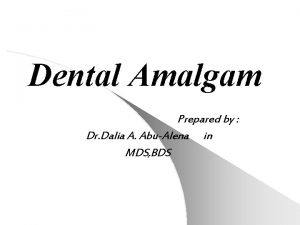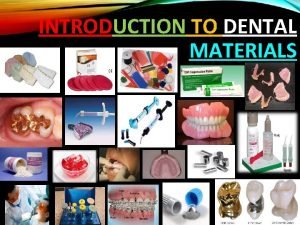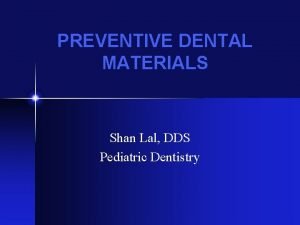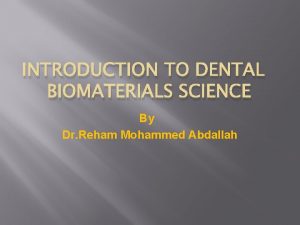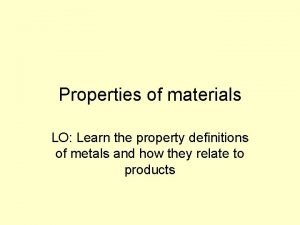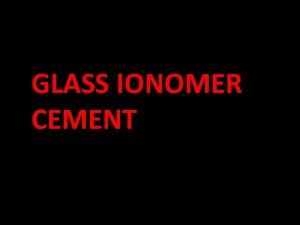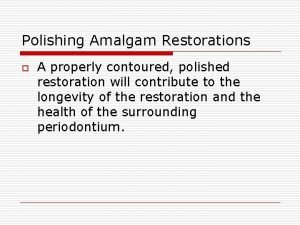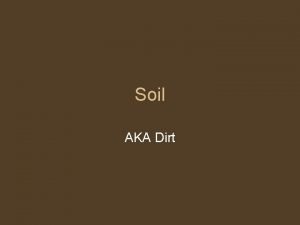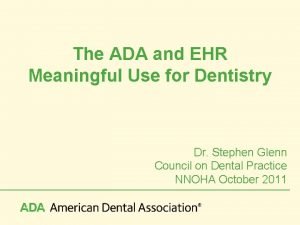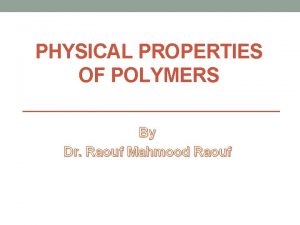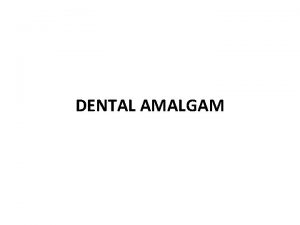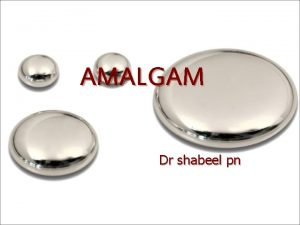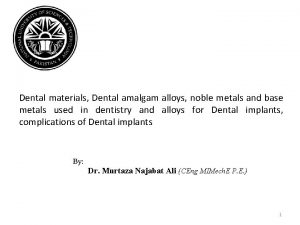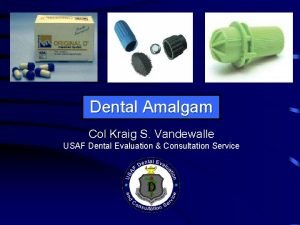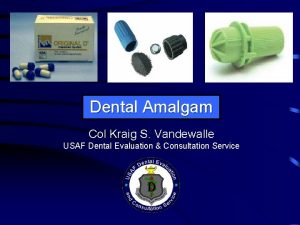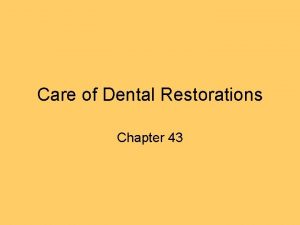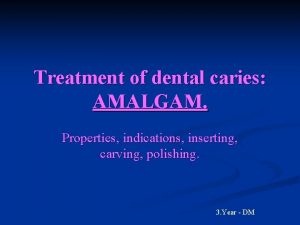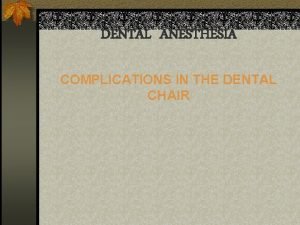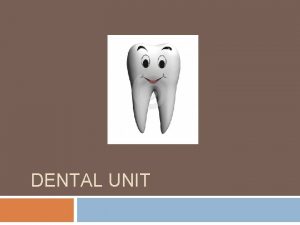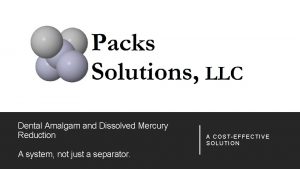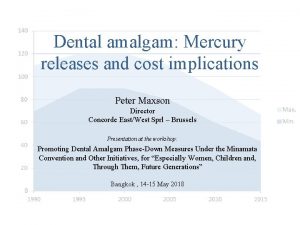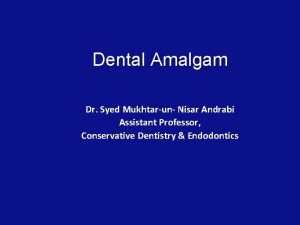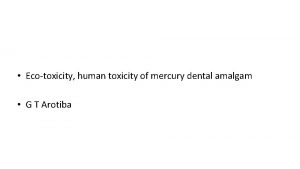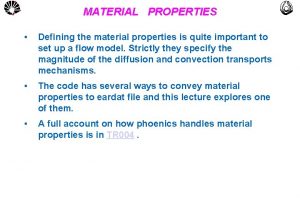Dental Amalgam Material Properties and its Use in



























- Slides: 27

Dental Amalgam: Material Properties and its Use in Clinical Dentistry J. Rodway Mackert, Jr. , DMD, Ph. D Medical College of Georgia Augusta, Georgia

What is Amalgam? a·mal·gam: any alloy of mercury with another metal or other metals [silver amalgam is used as a dental filling]† †Source: Webster’s New World Dictionary of the American Language, Guralnik DB, Ed. , New York: World Publishing Co. , 1972.

Types of Dental Amalgam • Copper amalgam (no longer used) • Conventional (low-copper) amalgam: formulation standardized in 1890’s • High copper amalgam: first developed in the 1960’s

Alloy Powder Composition Type Ag Low copper Sn Cu Zn Other 2 -7 0 -2 — 40 -70 26 -30 12 -30 0 -2 — 63 -72 26 -28 High-Cu admixed lathe-cut High-Cu admixed spherical High-Cu unicomp- ositional spherical 40 -65 0 -30 20 -40 0 0 -1 Pd 40 -60 22 -30 13 -30 0 -5 In, 0 0 -1 Pd compositions in weight percent

® Alloy Powder: Dispersalloy Mixing proportions: 50% alloy, 50% mercury

® Alloy Powder: Tytin Mixing proportions: 57. 5% alloy, 42. 5% mercury

Amalgam Capsules • Contain (in separate compartments): – powdered amalgam alloy – liquid mercury • Some are manually activated, others selfactivated • Pestle usually included

Amalgamator (Triturator) • Speeds vary upward from 3000 rpm • Times vary from 5– 20 seconds • Mix powder and liquid components to achieve a pliable mass • Reaction begins after components are mixed

Silver-Gold Phase Diagram

Silver-Tin Phase Diagram

Silver-Mercury Phase Diagram

Reaction: Low-Copper Alloys Ag 3 Sn( ) + Hg Ag 2 Hg 3( 1) + Sn 7 -8 Hg( 2) + Ag 3 Sn( )

Reaction: High-Copper Alloys Ag 3 Sn( ) + Ag-Cu + Hg Ag 2 Hg 3( 1) + Sn 7 -8 Hg( 2) + Ag 3 Sn( ) + Ag-Cu and Sn 7 -8 Hg( 2) + Ag-Cu Cu 6 Sn 5( ) + Ag 2 Hg 3( 1)

Composition of Set Amalgam • Matrix of 1 (Ag 2 Hg 3) and (Cu 6 Sn 5) phases, with embedded particles of unreacted (Ag 3 Sn) and Ag-Cu phases • Not a “solid emulsion” (“. . . it is not correct to refer to an aggregate of intermetallic compounds, all of which are solid at room temperature, as a solid emulsion. ” —Laurier Schramm, author of Dictionary of Colloid and Interface Science. )

Properties of Mercury • Only liquid metal at room temperature • Evaporation rate – Theoretical maximum is 57. 9 µg·cm 2·s– 1 from pristine, oxide-free surface into a vacuum (= 57, 900 ng·cm 2·s– 1) – Measured rate in vacuum is ~40 µg·cm 2·s– 1 (= ~40, 000 ng·cm 2·s– 1) – Oxidation of Hg lowers rate by factor of 1000

Université Laval 3. 7 -m LMT

Courtesy of E. F. Borra, Université Laval

Hg Evaporation from Amalgam • Baseline Hg vaporization rate (unstimulated) from amalgam in humans is 0. 027 ng·cm 2·s– 1 • Average vaporization rate (over 24 -h period) in humans is 0. 048 ng·cm 2·s– 1 • The evaporation rate of Hg from amalgam is 800– 1500 times lower than from oxidized mercury

Mercury Dose from Amalgam • Person with average number of fillings (7) would absorb ~1. 6 µg/day • Person with a moderately high number of fillings (13) would absorb ~3 µg/day • According to EPA, absorbed dose of mercury from food, water, and air is 5. 7 µg/day

Jerome Mercury Vapor Analyzer • Used by many antiamalgam dentists to measure intra-oral mercury vapor • Differences in sampling volumes and flow rates must be taken into account, or gross errors will result







 Trituration definition in dentistry
Trituration definition in dentistry What is solvent in science grade 7
What is solvent in science grade 7 Physical and chemical properties of dental materials
Physical and chemical properties of dental materials Geometrical dimensions and tolerances
Geometrical dimensions and tolerances Example of material culture
Example of material culture Non material culture examples
Non material culture examples Non material culture examples
Non material culture examples Look for the useful and harmful materials
Look for the useful and harmful materials Auxiliary dental materials definition
Auxiliary dental materials definition What are preventive dental material?
What are preventive dental material? Auxiliary dental materials
Auxiliary dental materials Material properties and definitions
Material properties and definitions Material properties definitions
Material properties definitions The emigree analysis
The emigree analysis Its halloween its halloween the moon is full and bright
Its halloween its halloween the moon is full and bright Matter and its properties
Matter and its properties Triangle and its properties project
Triangle and its properties project Trapezoids and kites 6-6
Trapezoids and kites 6-6 Extensive vs intensive quantity
Extensive vs intensive quantity Physical properties and chemical properties
Physical properties and chemical properties Material usage variance = material mix variance +
Material usage variance = material mix variance + Cusp capping definition
Cusp capping definition Miracle mix composition ratio
Miracle mix composition ratio Polishing of amalgam
Polishing of amalgam Soil located above its parent material
Soil located above its parent material Meaningful use dental
Meaningful use dental The sterilizing gas used in chemiclaves is
The sterilizing gas used in chemiclaves is Physical properties of polymers
Physical properties of polymers
